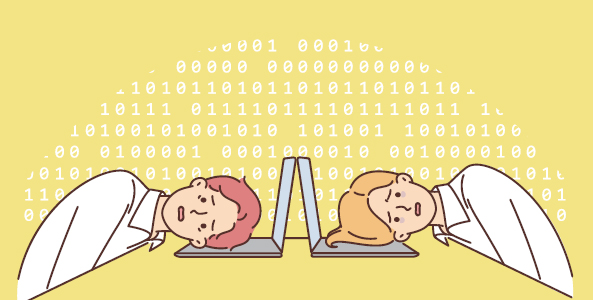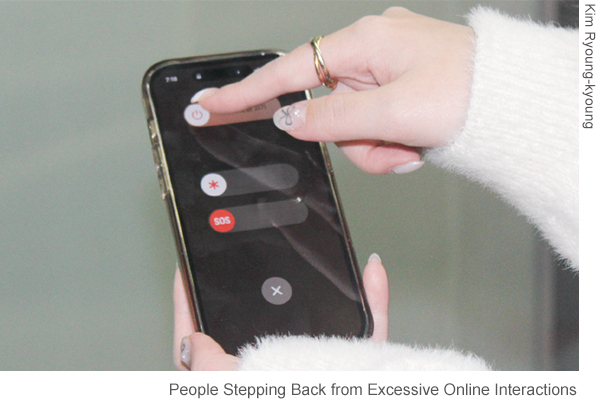Modern people wake up in the morning and encounter technology everywhere until they fall asleep at night. The digital era has accelerated as the COVID-19 pandemic allowed digital information to be carried out remotely in various fields such as economics, education, healthcare, labor, welfare, and politics.

Big data has allowed people to analyze unknown information, and cloud systems have enabled access to information anytime, anywhere. This has enabled people to cooperate naturally with others around the world and develop a digital society. However, a digital society does not always have positive effects.
With the advent of the digital age, the human brain has no time to rest; people have to make reasonable decisions with the increased amount of information and options. This can contribute to digital overload. Dysfunctions, such as social media flaunting and the digital divide, are also occurring currently in the digital era. In the past, people recognized and processed information through reliable media such as newspapers and other news outlets.
However, with the development of cyberspace, modern people have to deal with a daily flood of information from not only newspapers and traditional news, but also from various social media platforms and search engines. Taking all of this in can be disturbing for people, as can relying on an exponentially increasing amount of information.
What Causes Digital Overload?
Individuals and society are not sufficiently familiar with the information flood phenomenon, despite the convenience and benefits of a digital world full of readily available information. In the digital era, information is no longer scarce, but instead is overflowing, making people relatively less sensitive to new information than in the past. Therefore, people do not have to see or experience something in person to acquire new knowledge or have doubts; they can obtain the information through websites such as Google and Naver.
However, people have to spend a lot of time absorbing information and accepting it as knowledge because individuals have to sort information through facts and lies, nonsense and rumors. In other words, information availability has improved greatly, but its quality has not.
Digital overload is also caused by a tremendous increase in types of choices. In the digital age, people have to make decisions through a considerable number of choices recommended by algorithms or machine learning on the Internet. For instance, consider a case of an individual trying to make a choice when purchasing a product. In the past, one would have had to consider a limited number of options.
However, in today’s digital age, people are confronted with a vast array of choices from various online shopping platforms and global markets. This set of information recognition, classification, and determination can contribute to digital overload.
Side Effects of Digital Overload
Adverse effects can be observed due to digital overload. More and more people rely on social media or blindly follow the choices of influencers because of the proliferation of social media. A culture of showing off one’s wealth or personal connection is being formed through social media. Many people are flaunting food, fashion, cosmetics, luxury goods, and more, and the tendency of each person to show off one’s pride and seek validation through the praise of others is increasing.
The digital divide is also emerging as a dysfunction of the digital overload. Digital divide is the gap between people who have easy access to information and those who do not. This digital divide is expanding with the development of the Internet, which simultaneously causes economic and social gaps. Within digital culture and society, hierarchy and information asymmetry are emerging.
The Advent of Digital Detox
In the aftermath of the COVID-19 pandemic, workers struggling with digital overload has become a prevalent phenomenon in Korea. The pandemic has accelerated the adoption of remote work, telecommuting, and online activities, resulting in people spending more time connected to their digital devices. This excessive digital exposure has led to a growing sense of digital overwhelm, often referred to as “digital burnout.”
To address this issue, a new trend known as “digital detox” has emerged, offering a remedy for individuals seeking a break from the constant overload of digital information. The phrase “digital detox” is derived from the combination of “digital,” which represents digital devices like smartphones and computers, and “detox,” signifying a cleansing or purging process. This concept involves deliberately reducing screen time, stepping back from excessive online interactions, and redirecting one’s focus towards alternative, offline activities that can be enjoyed without a screen.
This digital detox trend has gained substantial momentum in Korea over recent years. Data analysis from Ssum Trend reveals a remarkable increase in the mentions of “digital detox” in online discussions. In the past year, discussions have surged, with the number of mentions of this term reaching 7,649, illustrating a rapid upward trajectory. A deeper examination of the discussions surrounding digital detox in Korea reveals a noteworthy shift in mindset and behavior among the younger generation, especially those in their 20s and 30s, often referred to as the 2030 generation. While these individuals have grown up in a digital world and are considered digital natives, they are the ones increasingly seeking a balance between their online and offline lives.
Analog Resurgence
The COVID-19 pandemic has served as a catalyst for this phenomenon. As the boundaries between work and personal life blur in an era of remote work and digital connectivity, people have recognized the importance of establishing clear boundaries and breaks from their digital obligations. As a result, an array of activities, such as reading, walking, and exercising have become preferred ways to unwind and decompress.

As they reduce their reliance on digital devices, many are rediscovering the joy of analog activities. Analog hobbies, characterized by their simplicity and focus on the tactile and tangible, have surged in popularity. Activities such as vinyl record collecting, film photography, and attending book clubs have become means of finding respite and serenity in a fast-paced, digital world.
This turn toward analog trends has been seen not only as a retreat from digital devices but also as an appreciation of the richness and authenticity of past experiences. The resurgence of Y2K aesthetics, the reminiscence of the early internet era, and the embrace of retro culture have all contributed to the newfound appreciation for analog activities. This trend toward digital detox and the resurgence of analog activities signifies a longing for simplicity, a break from the constant digital demands, and a desire to embrace a slower, more deliberate pace of life.

While these trends are indeed beneficial, they also underscore the importance of ensuring that individuals continue to engage with the digital realm in a balanced and mindful manner. In this rapidly changing landscape, the 2030 generation has the opportunity to redefine their relationship with technology, and to strike a harmonious balance between the digital and the analog in their pursuit of happiness and well-being.
Yim Soo-min
dlatnals@uos.ac.kr
Kim Ryoung-kyoung
ryoung0809@gmail.com

